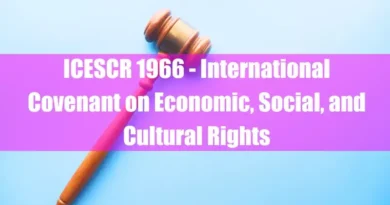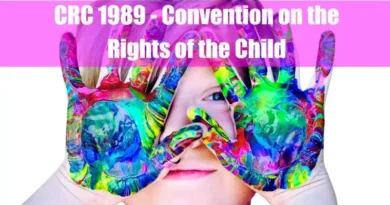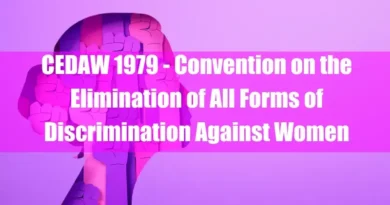CRPD 2006 – Convention on the Rights of Persons with Disabilities
Takeaways
| Key Points |
|---|
| The CRPD ensures that persons with disabilities enjoy equal rights and opportunities in areas like accessibility, education, employment, and healthcare while promoting dignity, autonomy, and non-discrimination. |
| The convention is guided by principles of respect for inherent dignity, non-discrimination, full participation in society, accessibility, gender equality, and respect for the evolving capacities of children with disabilities. |
| Key articles include provisions for equality and non-discrimination (Article 5), accessibility (Article 9), legal recognition (Article 12), inclusive education (Article 24), equal employment opportunities (Article 27), and adequate living standards (Article 28). |
Introduction
The Convention on the Rights of Persons with Disabilities (CRPD), adopted by the United Nations on December 13, 2006, is a landmark international treaty aimed at ensuring that people with disabilities enjoy the same human rights and freedoms as everyone else. The CRPD promotes dignity, autonomy, and non-discrimination while ensuring full societal participation. It covers areas such as accessibility, education, employment, and health care.
The CRPD also established a monitoring body, the Committee on the Rights of Persons with Disabilities, which reviews reports from participating countries to assess how well the convention is being implemented. The treaty has been ratified by the majority of UN member states, making it one of the most widely supported human rights conventions.
Purpose of the CRPD
The primary goal of the CRPD is to ensure that persons with disabilities enjoy the same rights and opportunities as everyone else. It covers a wide range of civil, political, economic, social, and cultural rights, aiming to eliminate discrimination and promote inclusion. The CRPD seeks to address barriers to accessibility and full participation in all aspects of life, including education, employment, and health care.
Key Principles of the CRPD
The CRPD is built on several fundamental principles that guide its application:
- Respect for inherent dignity and individual autonomy.
- Non-discrimination, ensuring people with disabilities are treated equally under the law.
- Full and effective participation in society.
- Accessibility, focusing on removing physical and social barriers.
- Equality between men and women, particularly addressing the intersectionality of disability and gender.
- Respect for the evolving capacities of children with disabilities and their right to preserve their identities.
Articles of the CRPD
The Convention consists of 50 articles that outline the specific rights and responsibilities of States Parties. Some of the most critical provisions include:
- Article 5: Equality and Non-discrimination – States are required to ensure that persons with disabilities are entitled to equal protection and benefits under the law.
- Article 9: Accessibility – States must take appropriate measures to provide accessible environments, including buildings, transportation, and information technologies.
- Article 12: Equal Recognition Before the Law – Persons with disabilities must enjoy legal capacity on an equal basis with others and be provided the necessary support to exercise that capacity.
- Article 24: Education – The CRPD requires inclusive education systems that provide persons with disabilities access to quality education without discrimination.
- Article 27: Work and Employment – The CRPD promotes the right to work and employment on an equal basis with others, advocating for an inclusive job market and protection against workplace discrimination.
- Article 28: Adequate Standard of Living – This article recognizes the right of persons with disabilities to adequate food, housing, and continuous improvement in living conditions.

Monitoring and Implementation Mechanism
The CRPD also established a Committee on the Rights of Persons with Disabilities, which oversees the implementation of the Convention by reviewing reports submitted by States Parties. This monitoring mechanism is crucial for ensuring that countries are held accountable for the progress they make toward achieving the objectives of the CRPD.
Additionally, civil society plays a significant role in implementation, particularly disabled people’s organizations (DPOs), which provide critical feedback and advocate for stronger national measures.

Optional Protocol
Along with the CRPD, an Optional Protocol was adopted, allowing individuals or groups to file complaints to the Committee if their rights under the Convention are violated and domestic remedies have been exhausted. This mechanism enhances the enforceability of the CRPD and provides a pathway for persons with disabilities to seek justice at the international level.
Global Impact and Challenges
Since its adoption, the CRPD has been ratified by over 180 countries, making it one of the most widely accepted international human rights treaties. While many countries have made significant strides in incorporating disability rights into their domestic laws aligning legal frameworks with the CRPD, progress varies considerably across regions. In particular, low- and middle-income countries face difficulties in fully aligning with the Convention due to limited resources or insufficient legal infrastructure.
Challenges remain in fully realizing the rights outlined in the CRPD. In many parts of the world, persons with disabilities still face significant barriers, especially in areas like education, employment, and health care. These barriers are often exacerbated by discrimination, stigma, and a lack of awareness about disability rights, which continue to be widespread issues.
Despite efforts, implementation is uneven, with some countries making substantial advances in promoting inclusion while others struggle to remove obstacles and create fully accessible environments. This discrepancy underscores the need for continued advocacy, resources, and awareness to ensure the CRPD’s goals are fully met globally.

Examples of National Implementation
Several countries have made notable efforts in implementing the CRPD. For example, Brazil has introduced robust accessibility laws and policies to improve the inclusion of persons with disabilities in public life. However, implementation remains uneven, and challenges persist, particularly in education, as highlighted by concerns over Decree 10.502/2020, which raised questions about weakening inclusive education. South Africa has incorporated disability rights into its national constitution and developed specific legislation to promote the inclusion of people with disabilities in the workforce.
In India, the Rights of Persons with Disabilities Act was passed in 2016 to align with the CRPD. This legislation mandates inclusive education, employment, and accessibility measures, marking a significant step forward in protecting disability rights.

Intersectionality and Gender
The CRPD recognizes the unique challenges faced by women and girls with disabilities, who often experience multiple forms of discrimination. Article 6 of the Convention addresses this by obligating States to take measures to ensure the full development, advancement, and empowerment of women with disabilities.
Role of International Organizations
International organizations, such as the World Health Organization (WHO) and UNICEF, have played a critical role in supporting the implementation of the CRPD. These organizations provide technical assistance, conduct research, and advocate for disability-inclusive policies in health, education, and disaster response areas.
Additionally, the World Bank and other international development organizations have committed to making their projects more inclusive, recognizing the need to incorporate disability perspectives into development planning. For example, the World Bank has pledged to ensure all its projects are disability-inclusive by 2025.

CRPD in the Context of the Sustainable Development Goals (SDGs)
The CRPD is closely aligned with the Sustainable Development Goals (SDGs), which include several disability-related targets. For instance, Goal 4 on education calls for inclusive and equitable quality education for all. In contrast, Goal 8 promotes sustained, inclusive economic growth and employment opportunities for all, including persons with disabilities.
Moreover, the SDGs emphasize the need to disaggregate data by disability to ensure that progress toward achieving the goals includes persons with disabilities. This aligns with Article 31 of the CRPD, which calls for collecting appropriate data to inform policy and ensure the effectiveness of disability rights measures.
Humanitarian Settings and Persons with Disabilities
Article 11 of the CRPD addresses the protection of persons with disabilities during risks such as humanitarian emergencies and armed conflict. Although this provision has contributed to more inclusive humanitarian aid, challenges remain in fully implementing accessibility. The Inter-Agency Standing Committee (IASC) developed guidelines for including persons with disabilities in humanitarian responses, with the CRPD helping shape policies that promote disability inclusion in international relief efforts.
Conclusion
- The CRPD represents a transformative shift in how the world views disability, moving from a charity-based approach to one centered on human rights and dignity.
- While significant progress has been made in implementing the provisions of the Convention, challenges remain in ensuring that persons with disabilities can fully enjoy their rights in all areas of life.
- The CRPD serves as a vital framework for countries, civil society, and international organizations to continue their efforts in promoting the rights of persons with disabilities, ensuring that no one is left behind in the pursuit of equality and human dignity.
FAQ
What is the CRPD?
The Convention on the Rights of Persons with Disabilities (CRPD) is an international human rights treaty adopted by the United Nations in 2006. It aims to promote, protect, and ensure the full and equal enjoyment of all human rights and fundamental freedoms by persons with disabilities.
When did the CRPD come into force?
The CRPD entered into force on May 3, 2008, after receiving the required number of ratifications. The United Nations General Assembly adopted it on December 13, 2006.
What is the purpose of the CRPD?
The purpose of the CRPD is to promote, protect, and ensure the full and equal enjoyment of all human rights and fundamental freedoms by all persons with disabilities, and to promote respect for their inherent dignity.
What does ‘discrimination on the basis of disability’ mean under the CRPD?
It refers to any distinction, exclusion, or restriction based on disability that impairs or nullifies the recognition, enjoyment, or exercise of all human rights and fundamental freedoms on an equal basis with others. This includes all forms of discrimination, including denial of reasonable accommodation.
What are ‘reasonable accommodations’ according to the CRPD?
Reasonable accommodations are necessary and appropriate modifications and adjustments that do not impose a disproportionate or undue burden, to ensure that persons with disabilities can enjoy or exercise all human rights and fundamental freedoms on an equal basis with others.
What is ‘universal design’ as defined in the CRPD?
Universal design refers to the design of products, environments, programs, and services to be usable by all people, to the greatest extent possible, without the need for adaptation or specialized design. It does not exclude assistive devices for particular groups of persons with disabilities where needed.
How does the CRPD define ‘communication’?
The CRPD defines communication as encompassing languages, display of text, Braille, tactile communication, large print, accessible multimedia, as well as written, audio, plain-language, human-reader, and augmentative and alternative modes, means, and formats of communication, including accessible information and communication technology.
What obligations do States Parties have under the CRPD?
States Parties are required to adopt all appropriate legislative, administrative, and other measures to implement the rights recognized in the Convention. This includes modifying or abolishing existing laws, regulations, customs, and practices that constitute discrimination against persons with disabilities.
What does the CRPD say about accessibility?
Article 9 of the CRPD mandates that States Parties take appropriate measures to ensure persons with disabilities have access, on an equal basis with others, to the physical environment, transportation, information and communications, and other facilities and services open or provided to the public.
How does the CRPD address the right to education?
Article 24 of the CRPD recognizes the right of persons with disabilities to education. It emphasizes the need for an inclusive education system at all levels and lifelong learning, aiming for the full development of human potential and a sense of dignity.
What provisions does the CRPD make regarding employment?
Article 27 of the CRPD recognizes the right of persons with disabilities to work on an equal basis with others. It obligates States Parties to prohibit discrimination in all matters concerning employment and promote self-employment, entrepreneurship, and career advancement opportunities.
How does the CRPD address health rights?
Article 25 of the CRPD recognizes that persons with disabilities have the right to the enjoyment of the highest attainable standard of health without discrimination. It calls on States Parties to provide the same range, quality, and standard of free or affordable health care and programs as provided to other persons.
What does the CRPD say about participation in political and public life?
Article 29 ensures that persons with disabilities can effectively and fully participate in political and public life on an equal basis with others, including the right to vote and be elected.
How does the CRPD address issues of accessibility in information and communication technologies (ICT)?
The CRPD emphasizes the importance of accessible ICT, urging States Parties to promote access for persons with disabilities to new technologies and systems, including the Internet, and to encourage the design, development, production, and distribution of accessible ICT at an early stage.
What measures does the CRPD suggest for awareness-raising?
Article 8 of the CRPD calls for measures to raise awareness throughout society regarding persons with disabilities, to foster respect for their rights and dignity, to combat stereotypes, prejudices, and harmful practices, and to promote awareness of the capabilities and contributions of persons with disabilities.









